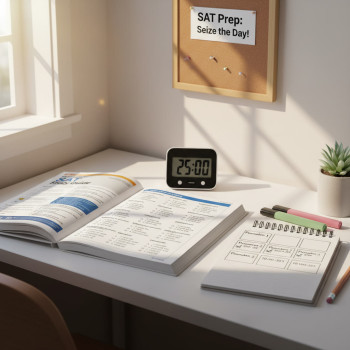AP vs SAT: Which Path Fits Your Business and Economics Ambitions?
Choosing the right testing path as a future business or economics student can feel like standing at a crossroads. Do you pack your high school transcript with AP courses to demonstrate subject mastery? Or do you focus on mastering the Digital SAT to present a strong, concise academic signal to colleges? The short answer is: both can matter but how and why they matter differs. This guide walks you through practical, student-focused comparisons and helps you build a strategy that fits your goals, timeline, and learning style.

Why this comparison matters for business and econ aspirants
Business and economics programs look for evidence of quantitative reasoning, problem-solving, and academic maturity. AP exams (especially AP Calculus, AP Statistics, AP Microeconomics, and AP Macroeconomics) show depth in specific subjects, often translating to college credit or advanced placement. The Digital SAT is a broader snapshot it highlights overall reading, writing, and math readiness and plays a major role in admissions decisions and scholarship eligibility.
Quick overview: Purpose, format, and outcomes
Start by seeing each test for what it is and what it s designed to signal.
- AP Exams: Subject-specific assessments that measure mastery in a particular discipline. Scoring is on a 1 5 scale; many colleges award credit or placement for scores of 3 5.
- Digital SAT: A general college-admissions test assessing Evidence-Based Reading & Writing and Math. Scores help colleges compare applicants on a standardized scale and can influence admissions decisions and merit aid.
What colleges value for business/econ majors
Admissions officers and departmental advisors typically weigh a combination of: coursework rigor (including APs), SAT/ACT scores, grades (especially in math), extracurriculars tied to leadership or finance, and essays. For economics and business, strong math and analytical evidence through AP Calculus/Statistics and strong SAT Math is especially persuasive.
Strengths and limits: AP exams
AP classes and exams let you demonstrate college-level mastery in a focused area. For business/econ hopefuls, certain APs are particularly relevant:
- AP Microeconomics shows foundational economics understanding at the micro level.
- AP Macroeconomics illustrates macroeconomic thinking and policy basics.
- AP Calculus AB/BC signals strong mathematical preparation for quantitative majors.
- AP Statistics highlights familiarity with data analysis, probability, and inference.
Benefits:
- Potential college credit or placement (helpful for lightening early semesters or accelerating to advanced coursework).
- Concrete evidence of subject mastery for admissions readers, especially when paired with strong grades in AP classes.
- Opportunity to build a specialized academic narrative e.g., I pursued AP Calculus and AP Micro to prepare for an economics major.
Limitations:
- AP exams are subject-specific and won t directly showcase overall literacy or reasoning skills in the same way the SAT does.
- Credit and placement policies vary widely by college a 4 at one school might earn credit, while another grants placement only.
Strengths and limits: Digital SAT
The Digital SAT assesses broad readiness for college-level work. Its adaptive, computer-based format emphasizes efficient problem solving, evidence-based reading, and a math section aligned with practical quantitative skills.
Benefits:
- Standardized signal used in admissions and scholarships helpful when schools compare applicants from different high schools.
- Emphasizes both reading and quantitative reasoning, which matters for business programs that value communication and analysis.
- Most colleges accept the Digital SAT and use it alongside or in lieu of other test scores when evaluating applicants.
Limitations:
- The SAT is a snapshot a single day performance can affect outcomes, so preparation and test-day strategy are key.
- Strong SAT scores are persuasive but don t replace the depth that AP subject exams provide in demonstrating mastery of economics or calculus.
Direct comparison: How AP and SAT measure different kinds of readiness
Think of the SAT as a broad lens and AP exams as zoomed-in portraits. Both offer complementary evidence.
| Feature | AP Exams | Digital SAT |
|---|---|---|
| Focus | Subject mastery (economics, calculus, statistics) | Overall reading, writing, and math reasoning |
| Format | Subject-based, written and multiple-choice components | Adaptive digital exam with reading/writing and math sections |
| Typical Use | Placement, credit, evidence of specialized knowledge | Admissions comparison, scholarship eligibility |
| Best For | Showing depth in a subject (e.g., AP Macro for econ) | Showing consistent, cross-subject academic readiness |
| Scoring | 1 5 scale; colleges set credit thresholds | Scaled score (used for admissions decisions) |
How to build a test plan for business/econ students
Here s a practical, semester-by-semester approach you can adapt. The goal: create a balanced profile that highlights both depth (APs) and breadth (SAT).
Freshman year
- Focus on strong grades build math foundations (Algebra, Geometry).
- Explore economics-related clubs or volunteer projects to see if you enjoy the subject.
Sophomore year
- Take Honors or early AP courses if available (AP Human Geography as an intro if offered).
- Begin light SAT practice to build familiarity aim for comfort with test timing and format.
Junior year (prime testing year)
- Enroll in AP Calculus AB or BC and AP Statistics if possible.
- Take AP Microeconomics or AP Macroeconomics (depending on which your school offers).
- Schedule Digital SAT attempt in spring or fall plan a second attempt if needed.
- Consider taking AP exams in May after dedicated review.
Senior year
- Finish remaining APs and take final AP exams in May.
- If SAT scores can still improve, use early fall for a last test before applications are due.
Realistic note: Many students mix and match for example, taking two or three APs in junior year while prepping for the SAT. Don t overload. Admissions officers prefer excellence over exhaustion.
Study strategy: Practical tips and sample routines
Effective study is deliberate and measurable. Here are strategies tailored for business/econ hopefuls.
For AP Economics (Micro & Macro)
- Focus on graphs and cause-effect relationships: supply-demand shifts, elasticity, GDP components.
- Practice free-response questions to build concise economic explanations with real-world examples.
- Form a weekly review habit: 30 60 minutes reviewing key models and vocabulary.
For AP Calculus and Statistics
- Daily problem practice beats marathon sessions. Aim for 30 45 minutes of focused problems.
- Master core techniques (limits, derivatives, integrals, distributions, hypothesis testing) with short summaries you can revisit quickly.
For the Digital SAT
- Take adaptive practice tests to understand pacing and the digital interface.
- Work on high-leverage math topics: linear equations, functions, ratios, basic geometry, and data interpretation.
- For reading, practice evidence-based questions: find the sentence or paragraph that supports the answer.
How colleges interpret combined signals
Admissions teams synthesize multiple signals. A strong AP profile tells them you ve tackled college-level material especially meaningful if you earn a 4 or 5 in AP Calculus or AP Statistics. A solid Digital SAT score helps standardize your abilities relative to students from other schools.
Example scenarios:
- High APs, moderate SAT: Shows subject strength. Some selective programs may want higher SAT scores, but excellent APs can support placement and demonstrate commitment.
- High SAT, few APs: Strong admissions signal; consider adding APs if you can to show depth before enrollment.
- High in both: Ideal combination broad readiness plus subject mastery.
Table: Sample priority matrix for different applicant goals
| Applicant Goal | Priority 1 | Priority 2 | Notes |
|---|---|---|---|
| Top-tier economics program | AP Calculus/Statistics | High Digital SAT Math | Emphasize quantitative rigor and strong math scores. |
| Business school (undergrad) | Combination of AP Economics and Math APs | Balanced Digital SAT | Show both domain interest and well-rounded skills. |
| State school with credit | AP Exams for credit | Digital SAT for admission | Check each college s credit policy AP credit can save time and money. |
How to present your story in applications
Numbers matter, but narrative ties them together. Use your application to show: why business/economics matters to you, how specific AP coursework shaped your thinking, and how your SAT preparation reflects your work ethic. Concrete examples a microeconomics research project, a statistics-driven club report, or a business competition bring scores and classes to life.
When and how to get help: tutoring, coaching, and targeted programs
Many students benefit from targeted help. Personalized tutoring can accelerate progress by focusing on your gaps and building a tailored plan. For example, Sparkl s personalized tutoring offers 1-on-1 guidance, tailored study plans, expert tutors, and AI-driven insights ideal for students who need an efficient, individualized path for both AP exams and the Digital SAT. The right tutor can make study time more effective and reduce test anxiety.
What to look for in a tutor or program
- Subject expertise: a tutor who knows AP Econ or AP Calculus deeply.
- Test-specific experience: familiarity with the Digital SAT format and timing.
- Personalization: study plans that adapt to your strengths and weaknesses.
- Progress tracking: regular practice tests and actionable feedback.
Common student questions answered
Do I need both APs and the SAT?
Not always. But if you re serious about business or economics, a combination is ideal: APs for depth and potential college credit; the SAT for a standardized admission signal.
Which APs are must-haves for econ/business?
AP Calculus (AB or BC), AP Statistics, and AP Micro/Macroeconomics are the most directly relevant. If you can take two or three of these, you ll demonstrate both quantitative and domain-specific readiness.
Can AP credit replace introductory college courses?
Sometimes. Policies vary. Some colleges give credit; others offer placement (skip the intro class but no credit). Always check the specific college s AP credit policy.
Real-world context: Coursework, internships, and portfolio building
Think beyond tests. Internships, investment club experience, economics research, or small business projects add practical weight to your application. Use AP coursework as a foundation, and let extracurriculars show application of that knowledge. Admissions committees value students who turn classroom theory into real-world action.
Final checklist: Building a balanced, competitive profile
- Take AP Calculus and AP Statistics if possible.
- Take AP Microeconomics or AP Macroeconomics to show domain interest.
- Schedule at least one Digital SAT practice test by early junior year; plan a realistic timeline for one or two official attempts.
- Use practice exams, targeted review, and short daily study blocks rather than cramming.
- Consider 1-on-1 tutoring for focused gains personalized plans and expert feedback can shorten your path to target scores.
- Develop one or two meaningful extracurriculars related to business or economics.
Parting advice: Your goals, balance, and the long view
Long-term success in business and economics isn t decided by a single test or exam it s built by steady curiosity, consistent work, and smart choices. AP exams give you depth and possible credits; the Digital SAT helps you compete in the admissions process. Together, they form a persuasive academic story. Aim for excellence, but keep balance: your well-being, extracurricular learning, and real-world projects matter just as much as scores.
If you d like a personalized roadmap a semester plan, which APs to choose based on your school offerings, or a tailored SAT prep schedule consider targeted tutoring to help you prioritize. With the right plan, you ll not only reach your scores, you ll start college ready to dive into economics and business with confidence.

Good luck and remember: the best plan is the one that matches your strengths, supports your growth, and keeps your curiosity alive.

















No Comments
Leave a comment Cancel